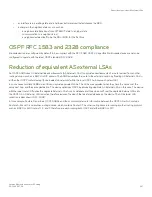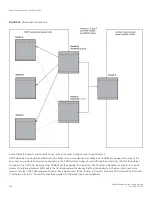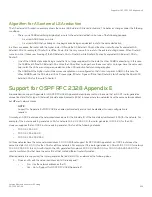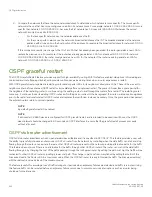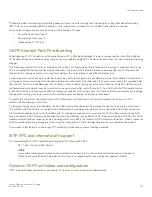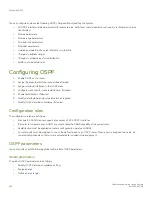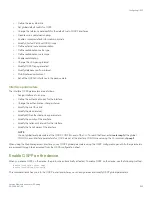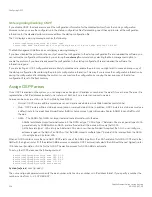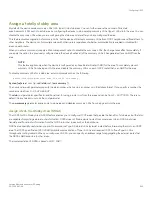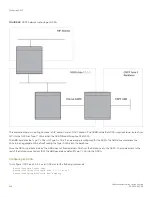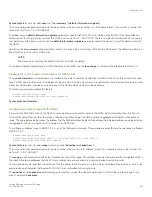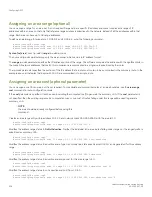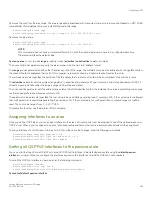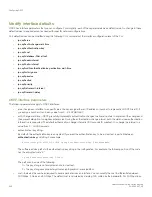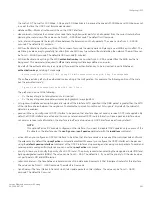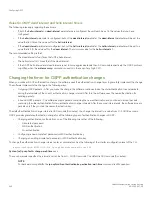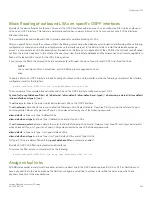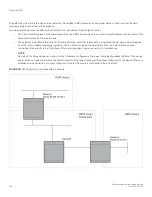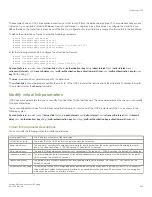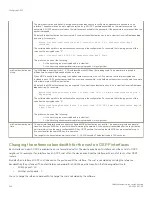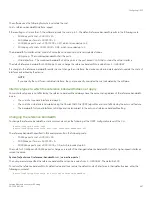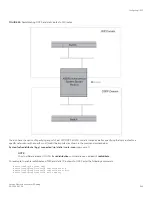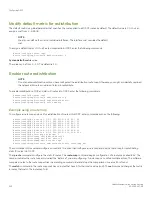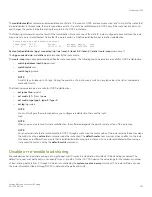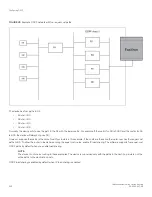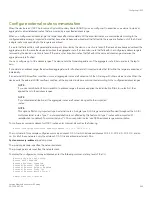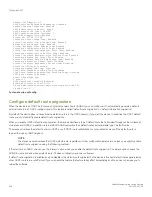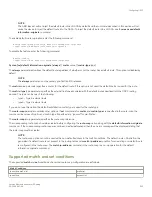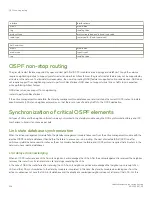
the cost is 10. The cost for 100 Mbps, 1 Gbps, and 10 Gbps links is 1, because the speed of 100 Mbps and 10 Gbps was not
in use at the time the OSPF cost formula was devised.
•
database-filter—Blocks all outbound LSAs on the OSPF interface.
•
dead-interval— Indicates the number of seconds that a neighbor router waits for a hello packet from the current router before
declaring the router down. The value can be from 1 - 65535 seconds. The default is 40 seconds.
•
hello-interval—Represents the length of time between the transmission of hello packets. The value can be from 1 - 65535
seconds. The default is 10 seconds.
•
MD5-authentication activation wait time—The number of seconds the device waits until placing a new MD5 key into effect. The
wait time provides a way to gracefully transition from one MD5 key to another without disturbing the network. The wait time can
be from 0 - 14400 seconds. The default is 300 seconds (5 minutes).
•
MD5-authentication key
string
—The MD5
authentication-key
is a number from 1 - 255 and identifies the MD5 key that is
being used. This parameter is required to differentiate among multiple keys defined on a router.
By default, the authentication key is encrypted. If you want the authentication key to be in clear text, insert a
0
between
authentication-key
and
string
. For example,
device(config-if-e10000-1/1/8)# ip ospf 1 md-5-authentication key-id 5 key 2 morningadmin
The software adds a prefix to the authentication key string in the configuration. For example, the following portion of the code
has the encrypted code "2".
ip ospf 1 md-5-authentication key-id 5 key 2 $on-o
The prefix can be one of the following:
–
0 = the key string is not encrypted and is in clear text.
–
1 = the key string uses proprietary simple cryptographic 2-way algorithm.
•
mtu-ignore—A database description packet is rejected if the interface MTU specified in the DBD packet is greater than the MTU
of the interface shared between the neighbors. To disable the mismatch condition set "mtu-ignore". By default, the mismatch
detection is enabled.
•
passive—When you configure an OSPF interface to be passive, that interface does not send or receive OSPF route updates. By
default, all OSPF interfaces are active and thus can send and receive OSPF route information. Since a passive interface does
not send or receive route information, the interface is in effect a stub network. OSPF interfaces are active by default.
NOTE
This option affects all IP subnets configured on the interface. If you want to disable OSPF updates only on some of the
IP subnets on the interface, use the
ospf-ignore
or
ospf-passive
parameter with the
ip address
command.
•
active—When you configure an OSPFv2 interface to be active, that interface sends or receives all the control packets and forms
the adjacency. By default, the
ip ospf active
command is disabled. Whenever you configure the OSPF interfaces to be passive
using the
default-passive-interface
command, all the OSPF interfaces stop sending and receiving control packets. To send and
receive packets over specific interfaces, you can use the
ip ospf active
command.
•
priority—Allows you to modify the priority of an OSPF router. The priority is used when selecting the designated router (DR) and
backup designated routers (BDRs). The value can be from 0 - 255. The default is 1. If you set the priority to 0, the device does
not participate in DR and BDR election.
•
retransmit-interval—The time between retransmissions of link-state advertisements (LSAs) to adjacent routers for this interface.
The value can be from 0 - 3600 seconds. The default is 5 seconds.
•
transit-delay—The time it takes to transmit Link State Update packets on this interface. The value can be from 0 - 3600
seconds. The default is 1 second.
Configuring OSPF
FastIron Ethernet Switch Layer 3 Routing
53-1003627-04
241
Summary of Contents for FastIron SX 1600
Page 2: ...FastIron Ethernet Switch Layer 3 Routing 2 53 1003627 04 ...
Page 16: ...FastIron Ethernet Switch Layer 3 Routing 16 53 1003627 04 ...
Page 20: ...FastIron Ethernet Switch Layer 3 Routing 20 53 1003627 04 ...
Page 142: ...FastIron Ethernet Switch Layer 3 Routing 142 53 1003627 04 ...
Page 150: ...FastIron Ethernet Switch Layer 3 Routing 150 53 1003627 04 ...
Page 200: ...FastIron Ethernet Switch Layer 3 Routing 200 53 1003627 04 ...
Page 214: ...FastIron Ethernet Switch Layer 3 Routing 214 53 1003627 04 ...
Page 350: ...FastIron Ethernet Switch Layer 3 Routing 350 53 1003627 04 ...
Page 476: ...FastIron Ethernet Switch Layer 3 Routing 476 53 1003627 04 ...
Page 588: ...FastIron Ethernet Switch Layer 3 Routing 588 53 1003627 04 ...

